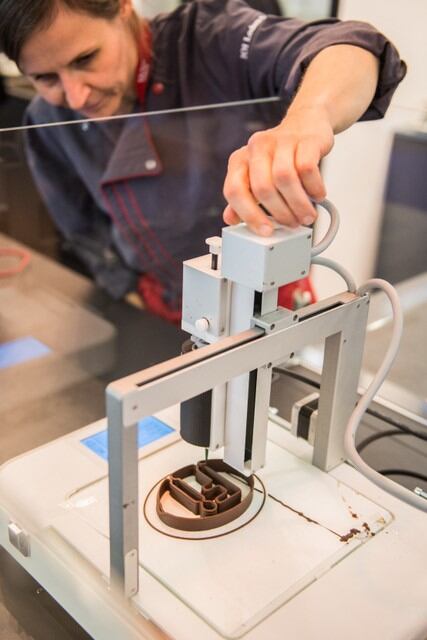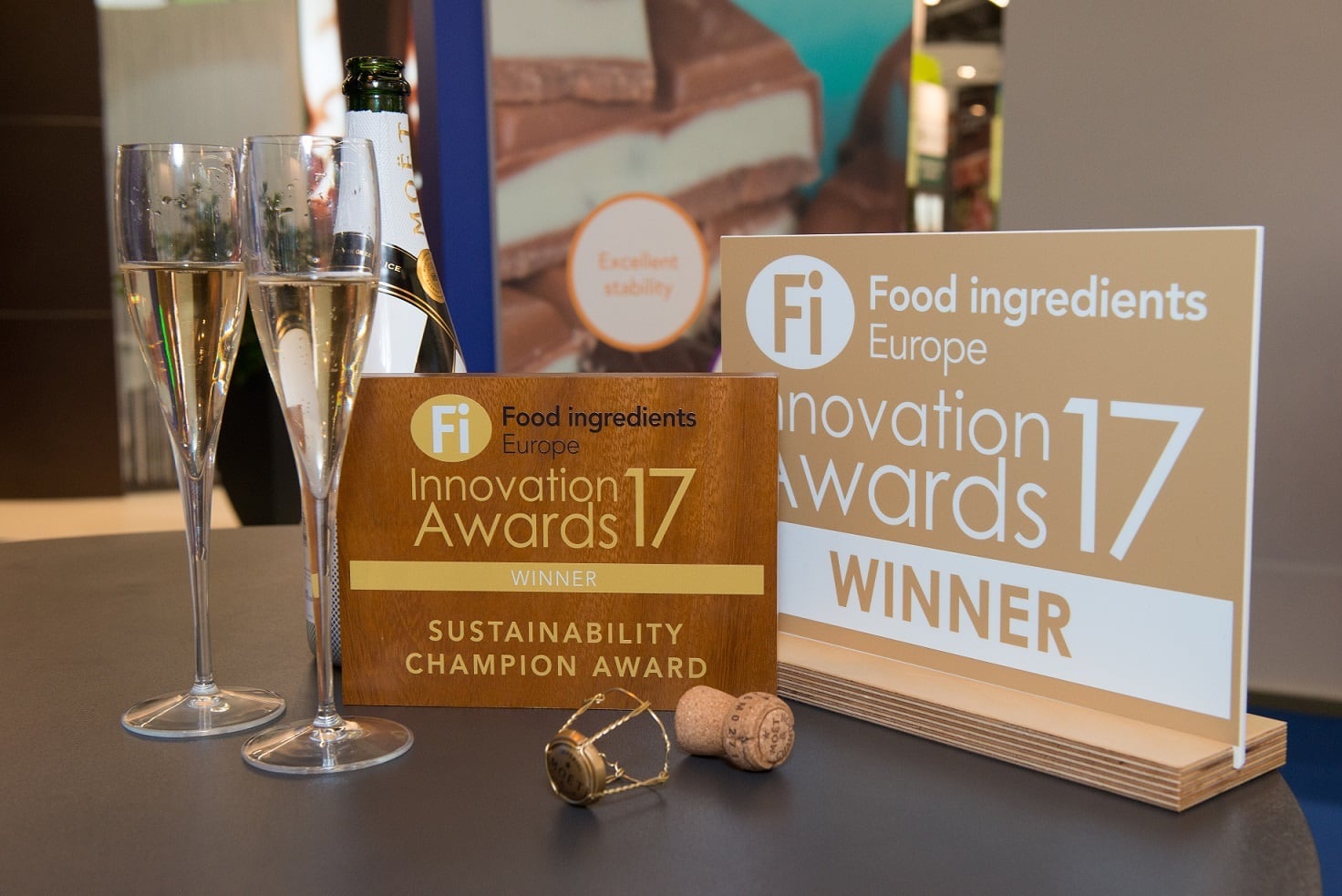IOI Loders Croklaan is working to position itself at the forefront of the trends and technology acting as disrupters in the food sector.
From the 3D printer on display at this year’s Food Ingredients Europe trade show to the consumer insight the company is sharing with its customers, the oil solutions provider wants to be in the vanguard of developments in the industry.
“The future is so close,” innovation chief Renee Boerefijn enthused as he outlined the key themes he believes will shape the product development in the coming years.

IOO Loders Croklaan demonstrated how its 3D printer can be used to deliver personalised chocolate products at Food Ingredients Europe in Frankfurt this November.
Technology & personalisation
Coming from an engineering background, it is perhaps unsurprising that Boerefijn sees great potential in technological advances that he believes will support the delivery of a truly personalised experience for consumers.
“Personalisation is also a unique opportunity for us and a trend still to come in many ways,” he told FoodNavigator at FiE last month. “Personalisation is currently seen as a way to break down the markets and target groups. That is not at all disruptive. We need to go way beyond that.”
In confectionery, for example, Boerefijn foresees a world where consumers can design a product using an app on their phones and then collect from a local producer – possibly a bakery of café.
IOI Loders Croklaan has a level of experience here that Boerefijn believes its food-maker customers can benefit from. “We need to deliver a truly personalised experience. We are a B2B company and that is something we need to do this in partnership with our customers. Today we are a company that produces a fresh product, just in time, produced to order. We do that on a massive scale with a huge variety of options. I think about 50% of our portfolio is customised. That positions us very well to support our customers to bring personalisation to the consumer.”
Boerefijn believes food makers must look beyond technical processes – such as 3D printers – to develop innovative ways of bringing these personalised products to market.
IOI Loders Croklaan is already working on this project. “I cannot say too much about that yet, but we are finding partners that think in the same way and that want to take their part in setting up, in essence, a whole new channel to the market,” he revealed.
Currently, this is something foodservice providers are more willing to embrace than food manufacturers. “That is how I also see this trend as a disruption, because food manufacturers – the traditional ones – see this more as a threat than an opportunity. That is where everybody has to learn and become more comfortable with this because at the end of the day, this works best if we work together and there is enough space for anyone.”
While developing new ways to bring a truly personal experience to consumers is a challenge it is “not nearly as big as we think it is”, Boerefijn suggested.
“When we look at this, we see ways that are relatively simple. Like 3D printers: we need to find a way of putting our components into a syringe. How difficult is that?”
Healthy indulgence
Personalisation and technology also have a role to play helping consumers eat more healthily – without sacrificing indulgence, Boerefijn predicted.
“When you see what kind of technology is built into our phones today in terms of health, I think we are very close to a time when our phone will tell us what we should eat in terms of calories but also in terms of indulgence. That is still a bit of an open space today. I see many developments on the phone side focusing on health- but I think indulgence should not be overlooked.”
Food makers are likely to continue to step up their response to the public health crisis through reformulation efforts. This cannot, however, be achieved at the expense of taste, Boerefijn insisted.
“The key thing is that we make a product that is great to enjoy. If we do not do that, any healthy alternative will not be the preferred choice. Then we push people away from the healthy choice for nothing. There is no compromise on preference.
“That is really the challenge we face as an industry, to make filling fat that has a premium melting experience and shortening fat that has a premium crispiness.”
IOI Loders Croklaan displayed a number of oils designed to reduce saturated fat content during FiE. These included Presdough 270SB is a second generation palm alternative based on shea that provides “extra puff” to facilitate a 20% fat reduction – and a 40% saturated fat reduction.
Boerefijn said fats can also play a role in sugar reduction efforts. “When you talk about sugar reduction I see that as a massive opportunity for us because if not sugar then it is really the fat that needs to deliver the structure and the texture. That is where we excel as experts understanding how we can deliver the mouthfeel with the right texture.
“Health will continue to be a great driver for innovation. That comes in many different forms: sugar reduction, saturated fat reduction, overall calorie reduction,” Boerefijn predicted. “I believe in perfectly indulgent, healthy products. It is essential that we do not compromise, that we make products that are perfectly preferred [in taste] and greatly healthy.”
Sustainability & traceability
Consumer interest in sustainability is growing. Boerefijn believes it is now up to food makers to communicate the progress in this area.
The jury of the Food Ingredients Europe Innovation Awards awarded IOI Loders Croklaan with the Sustainability Champion Award for the company’s efforts in building a traceable, transparent and sustainable palm oil supply chain.
The group's Palm Oil Sustainability Program consists of a three-step approach to trace palm oil back to the supplier mill and plantation level. The programme works in conjunction with the company's Sustainable Palm Oil Policy and the third-party supplier annex.

“We need to tell the story of all the good things that we as an industry are doing and make that fully transparent,” he argued. “Tech and data science are essential and helpful in showing good practices and building traceability.”
However, he warns that large western corporations must be mindful not to project their value-judgments on suppliers in developing countries. “Yes, there are things happening there that we don’t like. To some extent, they are a result of culture, tradition and history. I think we have to be careful before we impose our values and the principles of western society on a rich history and culture. We also need to have some respect.”
Traceability is a case in point, Boerefijn said. “If we as large corporate organisations impose our standards of operations in terms of traceability to smallholders in Asia and other places then very often we may push them out of the market. That is not corporate social responsibility – it is creating a competitive landscape that favours big western companies and pushes out smaller business. That is not what we want to do when we talk about traceability. We need to make sure everybody can win through this in terms of building a sustainable future for their families and children.
“I think it is one of the most important of all. It is not right that we take certain steps and then leave the rest behind. We need to go on this journey together. We need to be patient and respectful."
Digitalisation and consumer confusion
In order to deliver solutions for its customers, IOI Loders Croklaan places consumer insight at the heart of its innovation efforts.
“We very much look at consumer trends, we try to translate them to solutions that work for our customers. Our customers ask us to do this. I regularly get the question from my customer: ‘Tell me what my future looks like and what solutions do you bring to help me get there’. That is a very important activity – we really have to think about the future of our customers to help them grow. If they grow, we grow.”
Boerefijn observed that consumers today are “very critical” but also “easily misled”.
“We are all aware of the effect of certain blogs, which may be sometimes really dangerous and sometimes really helpful. We need to be careful that we know what it is that the consumer needs. When you look at nutritional science, meta-analysis about the role of fats and sugar, there are many insights coming out of that and many myths busted. As a science and an industry we need to be very careful that we do not confuse the consumer and that we are quite modest in the claims we make. We need to operate carefully to make sure what we say today proves true tomorrow.”
Boerefijn believes that ‘clean label’ trends are “here to stay” but added that there is a need to break down consumer misconceptions about the role of science and technology in food production.
“I think its important people realise that food when it comes to tech is not different from what goes on in their homes. People are too easily scared of what happens in the industry. It is not Frankenstein,” he stressed.
“There is a place for clean label but there is a much bigger place for transparency. [IOI Loders Croklaan] has existed for nearly 130 years, our tech is essentially the same. We have improved efficiency, we have scaled up, now some things are digital. But at the end of the day, our basic processes are still what they were 130 years ago. I believe we need to show that more.”
